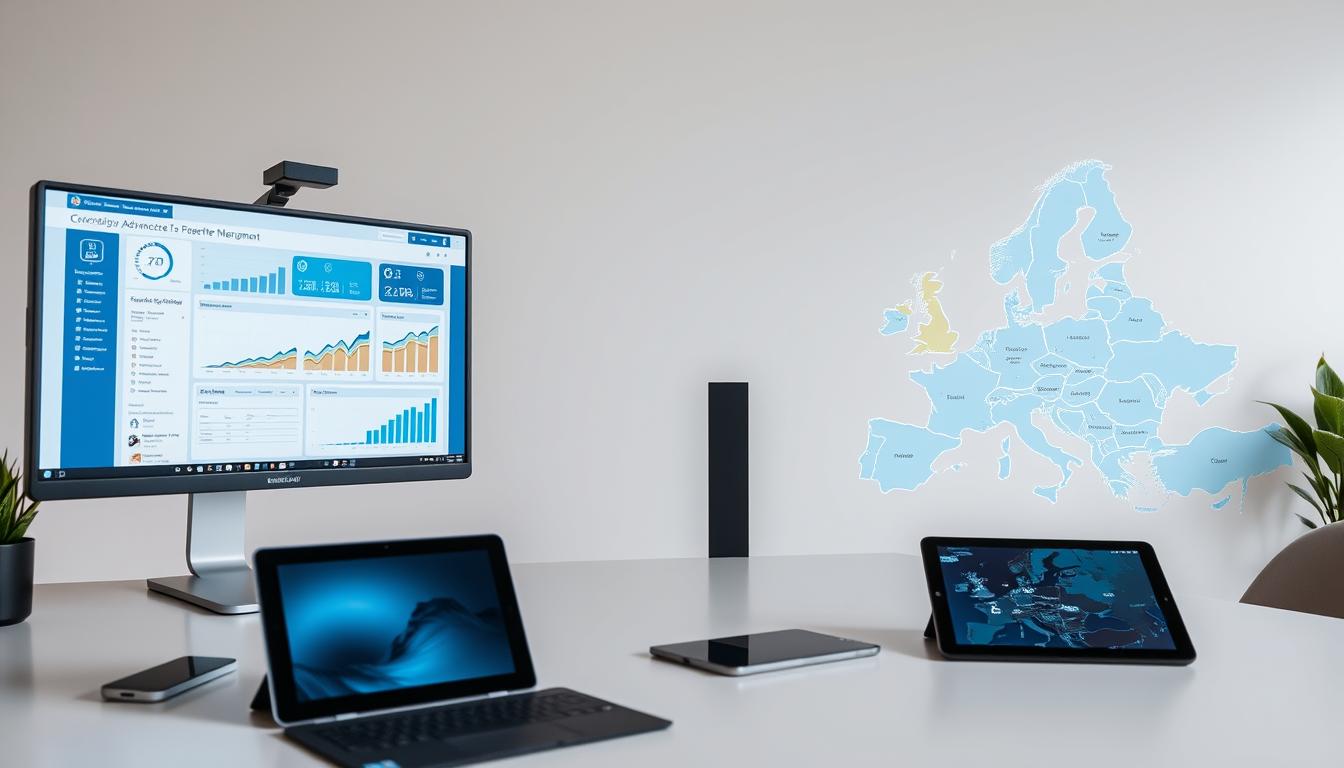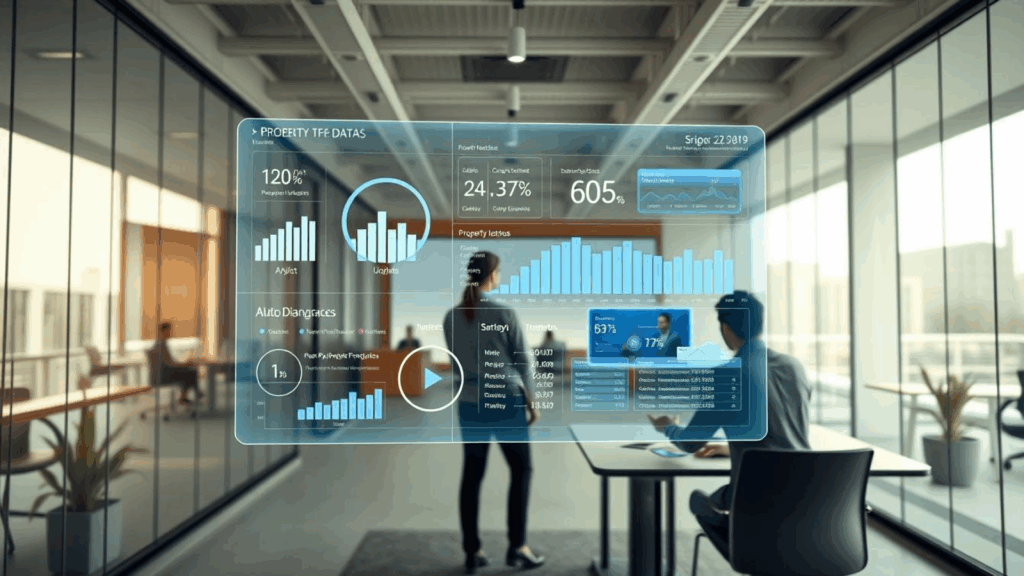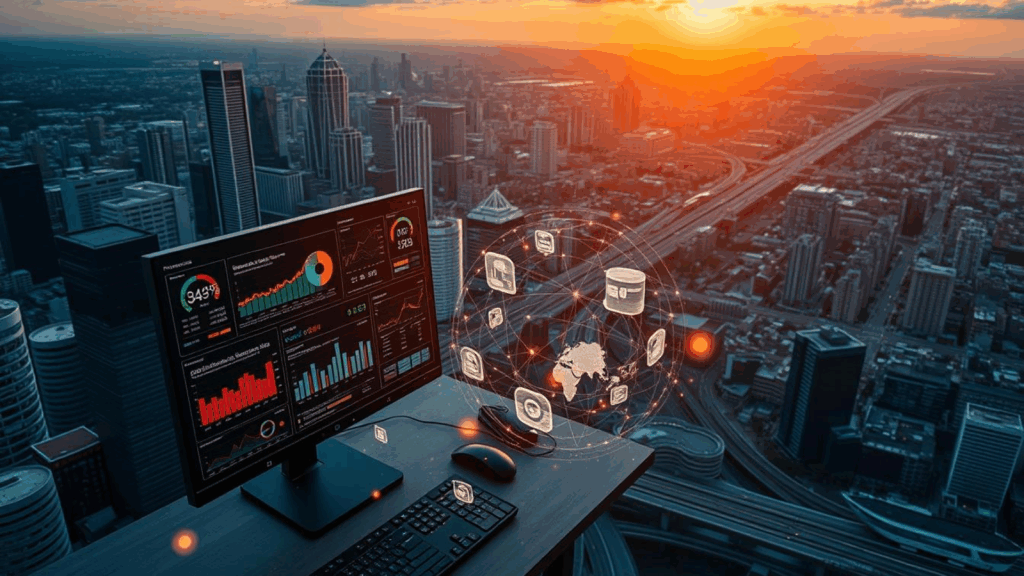In the EU, technical real estate managers face a complex landscape when choosing property management software. They manage diverse portfolios across multiple countries. It’s essential to find a solution that streamlines operations, boosts efficiency, and adapts to market changes. The right software is more than just features; it must meet your unique needs and comply with EU laws like GDPR and the AI Act.
When evaluating software, consider cloud-based versus on-premise options, integration with existing technologies, user-friendliness, and data security. Cloud-based systems are popular for their flexibility, scalability, and support for remote work. They offer automation, seamless integration, advanced security, and compliance tools.
Choosing the right software can significantly improve your operations. It can reduce paper use by up to 70%, increase productivity by 30%, and enhance customer satisfaction through automated maintenance. Integrating with vendor and technical management platforms further boosts efficiency.
When searching for software, look for key features like accounting, financial management, automated rent collection, tax management, customizable reporting, and support for multiple properties. Case studies of successful EU implementations can offer valuable insights into how these solutions have transformed real estate operations.
Key Takeaways
- Choose property management software that aligns with your unique needs and helps you stay compliant with EU regulations like GDPR and the AI Act
- Consider cloud-based solutions for flexibility, scalability, and support for remote and hybrid work models
- Look for essential features like accounting, automated rent collection, tax management, reporting, and multi-property support
- Integrate with vendor communication and project management platforms to enhance efficiency and streamline processes
Understanding the Needs of Technical Real Estate Managers
Technical property managers and technical asset managers play unique roles in the real estate sector. They require specialized software to fulfill their duties. Technical property managers handle the technical aspects of property management. On the other hand, technical asset managers focus on investments to achieve financial goals for their clients. Both need software that meets their specific needs, avoiding the complexity of facility management software.
When looking at EU real estate tools, it’s vital to grasp the unique demands of technical real estate managers. Cloud-based property management software is gaining traction. It eliminates the need for a physical office, allowing access to vital information and tools from anywhere with internet. This flexibility is crucial for technical property managers managing properties across various locations.
Cloud platforms also enhance communication between property managers, vendors, and tenants through online portals and messaging systems. This is key for technical property managers who handle multiple aspects of property management. Cloud solutions are scalable, adapting to changing needs and supporting business growth.
When crafting a purchasing guide for property management software, focus on features that streamline workflows and boost tenant satisfaction. Automated maintenance management software, for instance, helps property managers optimize their processes with real-time updates. Vendor communication tools integrated with platforms simplify service provision by centralizing contracts and improving communication.
User-friendliness is a critical factor in selecting property management software. Intuitive interfaces speed up adoption and reduce training needs for both professionals and tenants. This enhances the overall user experience. Online portals with tenant self-service features further boost tenant engagement by allowing them to manage rent payments and maintenance requests independently.
Essential Features of Property Management Software
Technical real estate managers should focus on key features when choosing property management software. Lease management tools are vital, allowing for digital lease agreements with customizable terms and payment options. Platforms like Avail and TurboTenant provide lawyer-reviewed templates, ensuring compliance with laws.
Effective eviction management is crucial, offering tools to handle delinquent tenants and track overdue payments. Software should include tools for troubleshooting delinquency reports, fixing missing or incorrect data.
Maintenance scheduling is a key feature, providing tools to streamline this process. From tracking work orders to managing vendors, a centralized platform reduces time and effort in maintaining properties.
Other essential features include:
- Monthly financial reports with customizable options for accurate insights
- Convenient bill pay solutions for handling electronic fund transfers and checks
- Online payment portals to collect rent, reducing delays and manual tracking
- Tenant screening integration for background checks and application management
- Responsive customer service, such as live chat and phone support
- Listing syndication to popular rental sites like Zillow and Apartments.com
- Digital rent collection through credit, debit, and ACH transfers
- Integration with accounting software like QuickBooks, Yardi, Exact, AFAS, AAREON REMS, Microsoft Business Central for synchronized bookkeeping
By focusing on these features, technical real estate managers can select software that offers a centralized platform. This platform provides real-time data, generates reports, and efficiently manages multiple properties across the EU.
Benefits of Using Property Management Software
Property management software brings numerous benefits, enhancing operational performance and streamlining global property management. It allows technical real estate managers in the EU to track diverse holdings across multiple countries. They can make data-driven decisions and offer an intuitive user experience for their teams.
One key advantage is the potential for reduced operating costs. A survey by Software Advice found that 53% of property managers have lowered their operational expenses by using a Property Management System (PMS). These systems also help cut the time spent on administrative tasks by half or more.
Moreover, property management software boosts tenant satisfaction and retention. In fact, 78% of renters say online payment options significantly increase their satisfaction. By offering online lease signing, tenant screening, and automated rent payments, managers can build long-term tenant relationships and meet tenant expectations.
| Benefit | Impact |
|---|---|
| Real-time data access | Quicker responses to tenant inquiries and issues |
| Data analytics | Monitor financial trends, analyze tenant behaviors, optimize property performance |
| Integrated PMS | Reduce turnover and vacancy rates, foster long-term tenant relationships |
The global property management software market is expected to grow from $24.18 billion in 2024 to $50.19 billion by 2032. This growth highlights the increasing demand and reliance on these systems in the EU real estate industry. As more property managers adopt these solutions, the benefits of centralized management, automated financial operations, enhanced communication, and real-time reporting will continue to drive adoption.
Cloud-Based vs. On-Premise Solutions
Technical real estate managers in the EU must decide between cloud-based and on-premise property management software. Cloud-based systems offer flexibility, scalability, and cost-effectiveness. They allow users to access the platform from any device and browser, making them perfect for managing global portfolios.
On-premise solutions are favored by those with strict data security needs. They provide full control over data and infrastructure, ensuring high data security. These systems also offer customization and integration capabilities, allowing for adaptation to unique business needs.
The choice between cloud-based and on-premise solutions depends on several factors. These include the size of the property portfolio, budget, and data security requirements. Below is a table highlighting key differences between the two options:
| Cloud-Based Solutions | On-Premise Solutions |
|---|---|
| Favored by smaller accommodation businesses due to cost-effectiveness and mobility requirements | Preferred by 47% of hoteliers in the EU due to control and security concerns |
| Witness a yearly growth rate of 15% in the European hotel industry | Require an additional investment of approximately 22% for maintenance and upkeep |
| Offer scalability, allowing property managers to easily expand their portfolios | Provide high levels of reliability and performance when optimized with robust hardware and network infrastructure |
| Handle updates, patches, and maintenance tasks automatically | Require regular maintenance and updates managed by property management companies or external IT support |
The decision between cloud-based and on-premise software should be based on a thorough evaluation. Consider the organization’s specific needs, budget, and long-term goals. By weighing the pros and cons, technical real estate managers can choose the best solution for their operations.
Property Management Software
When choosing property management software, focus on solutions with an intuitive interface. This ensures your team can quickly adapt. Features like pre-defined checklists and templates help standardize processes, boosting efficiency and consistency across your portfolio.
Opt for software that includes external vendors and subcontractors at no extra cost. This can greatly simplify your workflow. Features like custom websites, full accounting systems, tenant screening, and online file management. Seek software tailored to your specific needs, whether you manage residential or commercial properties.
The ideal property management software will streamline your daily tasks and boost efficiency. This allows you to concentrate on expanding your business and delivering outstanding service to your tenants and clients.
Integration with Other Real Estate Technologies
Choosing the right property management software means looking at its integration capabilities. An open architecture ensures smooth connections with top-notch solutions. This boosts efficiency and streamlines processes. For example, Proprli, a leading technical management platform, works well with EU property management software like Yardi, REMS and Axxerion.
Integrations make tasks like inspections and maintenance easier. They keep critical tasks on track and provide real-time updates to all involved.
Good communication and teamwork are key, thanks to integrations. This makes managing properties more efficient and effective.
| Software | Integration Benefits |
|---|---|
| Proprli | Can sync property details, preferred suppliers, and tenant contact information automatically with systems like Yardi, Axxerion, and REMS |
McKinsey found that 73% of IT leaders save 25% of their time through automation. This highlights the value of integrating automation into property management. By embracing open architecture, API and top solutions, managers can enhance operations, tenant satisfaction, and business growth in the EU.
User-Friendliness and Ease of Adoption
When choosing property management software, ease of use is paramount. An intuitive web-based interface and mobile access boost productivity by up to 25%, as PropertyManagementInsider.com reports.
SoftwareAdvice.com’s survey reveals modern property management software offers 7 customization options. This allows users to personalize the software to fit their specific needs.
Slow software performance is a significant pain point for property managers. UserExperience.com notes that 92% of them face this issue, with an average of 7 system crashes or freezes monthly. To combat this, companies like Proprli have automated scaling within their cloud-based infrastructure.
When assessing property management software, focus on solutions with high approval ratings for their user-friendly interfaces and comprehensive features.
Ensuring Data Security and Privacy
Data security and privacy are critical in property management software. Sensitive tenant information is stored and processed, making robust security measures essential. Look for software with secure cloud storage, data encryption, and regular backups to prevent breaches and unauthorized access.
Two-factor authentication (2FA) adds a crucial security layer to user accounts. It ensures only authorized personnel can access tenant data. Data encryption, both at rest and in transit, protects sensitive information from cyber threats. Property management software should also minimize data at risk.
Compliance with data protection regulations, like GDPR in the EU and CCPA in the US, is vital. Choose software that offers automated compliance reporting. This makes it easier to show adherence to these regulations. Audit trails are also important, as they document all actions with tenant data, promoting accountability and transparency.
| Security Feature | Importance |
|---|---|
| Two-factor authentication | Adds an extra layer of security to user accounts |
| Data encryption | Protects sensitive information from cyber threats |
| Regular software updates | Addresses security vulnerabilities and enhances protection |
| Secure cloud storage | Ensures data protection against loss and unauthorized access |
| Data backups | Enables quick and efficient recovery in case of data loss |
When evaluating property management software, ask about the provider’s data security measures and compliance with regulations. Prioritizing data protection and privacy ensures the safety of tenant information. This allows technical real estate managers to benefit from the efficiency and convenience of property management software.
Conclusion
In today’s competitive real estate market, EU technical real estate managers must adapt strategically to ensure future success. Choosing the right property management software is crucial. It can greatly impact operational efficiency, tenant satisfaction, and long-term growth. Managers should evaluate their needs and look for essential features like tenant management, online payments, and maintenance management.
Implementing the right software offers many benefits. It increases efficiency, enhances the tenant experience, and supports data-driven decision-making. Automation of routine tasks saves time and boosts accuracy. Centralized systems improve organization and streamline processes.
Improved communication through dedicated portals leads to faster issue resolution. This results in higher tenant satisfaction, better retention, and positive referrals. As the market evolves, partnering with a reliable software provider is key.
By investing in effective property management software and focusing on continuous improvement, EU technical real estate managers can achieve long-term success. They will thrive in an increasingly competitive landscape.
FAQ
What are the key differences between technical property managers and technical asset managers?
Technical property managers oversee the ongoing technical aspects of real estate. They handle maintenance and development. On the other hand, technical asset managers focus on investments to meet financial goals. Both roles need software that supports their tasks without the complexity of managing facilities.
What are the essential features to look for in property management software?
Look for lease and eviction management, maintenance scheduling, and property accounting. The software should offer a centralized platform for managing multiple properties. It should also provide real-time data and report generation capabilities.
How can property management software benefit technical real estate managers in the EU?
Property management software boosts operational performance and efficiency. It helps managers track diverse holdings across multiple countries. It also enables data-driven decisions and offers an intuitive user experience for teams.
What are the advantages of cloud-based property management software?
Cloud-based software offers flexibility, allowing access from any device and browser. This is great for managing global property portfolios. On-premise solutions might be better for companies with strict data security needs.
What user-friendly features should property management software have?
The software should have an intuitive interface that’s easy for your team to use. Look for customizable features like pre-defined checklists and inspection templates. The ability to include external vendors and subcontractors without extra cost is also valuable.
How important is integration with other real estate technologies?
The software should have an open architecture for integration with other real estate technologies. This could include BIM models for high-quality property data or importing schedules from project management software for renovations.
What should technical real estate managers consider regarding data security?
Property management software stores sensitive data, so ensure the provider has strong security measures. This includes secure cloud storage, data encryption, and regular backups. The software should also comply with data protection regulations like GDPR in the EU.






